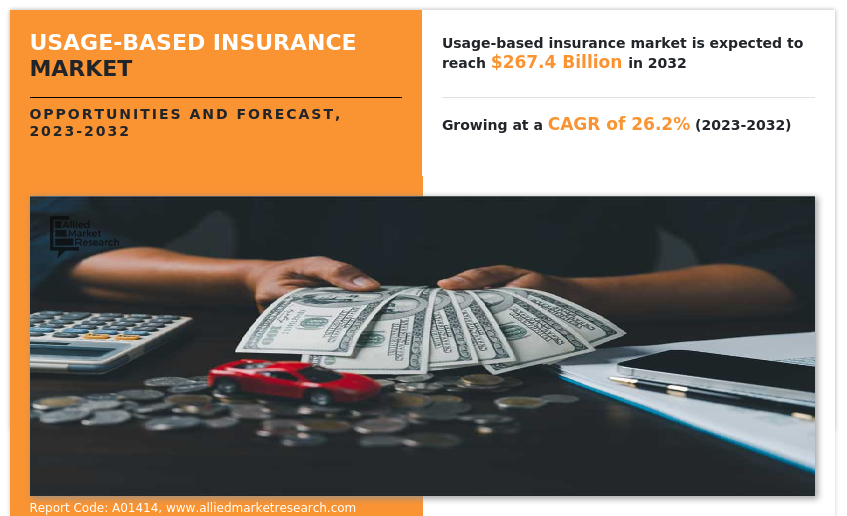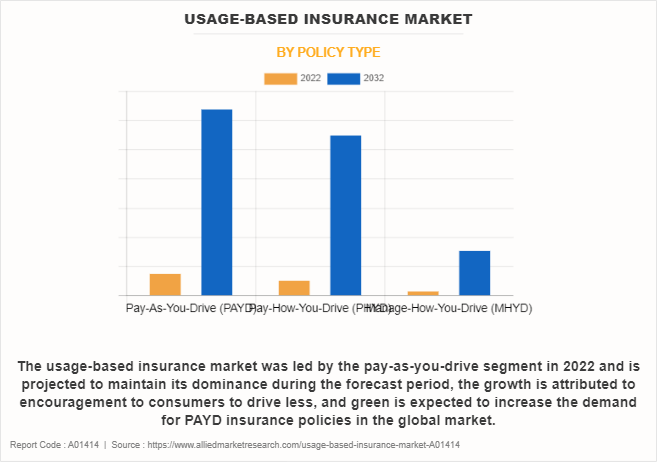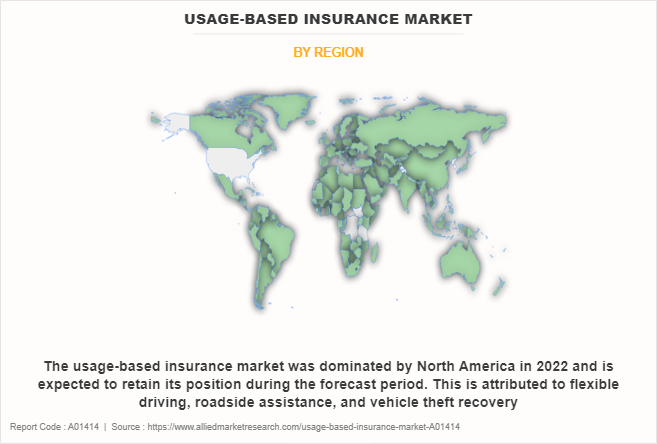Usage-Based Insurance Market Research, 2032
The global usage-based insurance market was valued at $26.8 billion in 2022, and is projected to reach $267.4 billion by 2032, growing at a CAGR of 26.2% from 2023 to 2032.
Usage-based insurance is called telematics insurance, which is known for the insurance policy that analyses the premium based on the usage of a vehicle or consumer driving behavior. User-based insurance includes various technologies, such as onboard diagnostic (OBD) II, black box, and smartphones. It effortlessly examines the reason for an accident, improves customer loyalty, and reduces claim fraud.

Growing adoption of usage-based insurance among the end user owing to its various features such as providing accurate and timely data collection methods and flexible insurance premiums boosts the growth of the global usage-based insurance market. In addition, factors such as the higher possibility of the vehicle being recovered, in case of stolen, and lower fuel consumption have positively impacted the growth of the market. However, the high installation cost of telematics and various data security issues are expected to hamper the market growth. On the contrary, the adoption of advanced technology such as smartphone-based UBI & hybrid-based UBI and an increase in concerns regarding driver's safety across the globe is expected to offer remunerative opportunities for the expansion of the market during the forecast period. Each of these factors is projected to have a definite impact on the growth of the usage-based insurance market forecast.
Segment Review
The usage-based Insurance market is segmented by type, technology, vehicle age, vehicle type and region. In terms of type, the market is fragmented into pay-as-you-drive insurance (PAYD), pay-how-you-drive insurance (PHYD), and manage-how-you-drive insurance (MHYD). Depending on technology, it is bifurcated into OBD-II-based UBI programs, smartphone-based UBI programs, hybrid-based UBI programs, and black-box-based UBI programs. As per vehicle age, the usage-based Insurance market is bifurcated into new vehicles and used vehicles. In terms of vehicle type, the market is segmented into light-duty vehicles (LDV) and heavy-duty vehicle (HDV). Region-wise, it is analyzed across North America, Europe, Asia-Pacific, and LAMEA.

By policy type, the usage-based insurance market size was led by the pay-as-you-drive segment in 2022, and is projected to maintain its dominance during the forecast period. Encouragement to consumers to drive less and green is expected to increase the demand for PAYD insurance policies in the global market. However, the manage-how-you-drive segment is expected to grow at the highest rate during the forecast period, owing to technological advancement and a rise in awareness among the youth is projected to attract many new consumers, which boost the global usage-based insurance market.

Region wise, the usage-based insurance market share was dominated by North America in 2022, and is expected to retain its position during the forecast period. This is attributed to flexible driving, roadside assistance and vehicle theft recovery. However, Asia-Pacific is expected to witness significant growth during the forecast period, owing to consumer awareness and major player of the market targeting developing countries of Asia-Pacific.
The key players profiled in the usage-based insurance market analysis are Allianz SE, Allstate Corporation, Aviva, AXA, Insurethebox, Liberty Mutual Insurance, Mapfre S.A., Nationwide Mutual Insurance Company, Progressive Corporation and UNIPOLSAI ASSICURAZIONI S.P.A. These players have adopted various strategies to increase their market penetration and strengthen their position in the industry.
Market Landscape and Trends
Usage-Based Insurance (UBI) market has become a transformative force in the insurance industry, reshaping traditional models by leveraging technology to tailor coverage based on individual behaviour. The market landscape and trends in Usage-Based Insurance reflect a dynamic shift toward personalization, risk mitigation, and technological innovation. Moreover, UBI has gained widespread adoption globally, with insurance providers in various regions offering usage-based products. In addition, the market is expanding beyond traditional boundaries, reflecting a growing demand for personalized insurance solutions. Furthermore, the integration of telematics and Internet of Things (IoT) technologies is fundamental to UBI, enabling real-time data collection on driving behaviour. The COVID-19 pandemic has accelerated the digital transformation of the insurance industry. Furthermore, the Usage-Based Insurance landscape is characterized by a shift from one-size-fits-all policies to personalized, data-driven solutions. As technology continues to advance, and consumers seek more tailored insurance experiences, UBI is likely to remain a key driver of innovation and change in the usage-based insurance industry.
Competition Analysis
Recent Partnerships in the Usage-Based Insurance Market
August 24, 2023: Citroen India partnered with ICICI Lombard General Insurance to provide greater everyday value and convenience where it matters most to consumers. Mastercard's U.S. usage-based Insurance market card products empower cardholders with access to over $60bn+ in meaningful rewards and benefits. Moreover, New offerings with Instacart and Peacock bring value directly to consumers where they frequently spend.
Recent Product Launches in the Usage-Based Insurance Market
In September 11, 2023, Definity launched new usage-based insurance (UBI) market offering to provide drivers unprecedented control over their premiums while promoting safer driving practices.
Recent collaboration in the Usage-Based Insurance Market
On November 14, 2022, CerebrumX platform collaborated with Ford connected vehicle data to support its data-driven usage-based insurance (UBI)-as-a-Service model for Insurers. This model offers a quicker and more cost-effective implementation of UBI programs by using embedded telematics for eligible Ford and Lincoln connected vehicles.
Top Impacting Factors
Rise in Adoption of Usage-based Insurance Among end Users
Accurate and timely data collection is among the major factors that boost the growth of the usage-based Insurance market. It allows insurers to price premiums more accurately, which increases affordability for lower-risk drivers. In addition, it provides consumers with a record of all their trips or miles covered during a particular period. The surge in acceptance of telematics devices and the rise in popularity of pay-as-you-drive insurance plans help to drive market expansion. Telematics devices permit insurers to collect complete data on a policyholder's driving conduct, it offers extra modified coverage.
Data sets can represent about 5 to 15MB of data annually, per policyholder, depending on the frequency and length of trips taken. An insurer with 100,000 insured vehicles can collect more than one terabyte of data per year. The type of data recorded and transmitted from cars vary according to the telematics technology chosen by policyholders. Thus, to manage large amounts of telematics data obtained from automated cars, many insurance service providers are adopting usage-based insurance, which drives the growth of the usage-based insurance market.
Flexible Insurance Premiums
UBI service enables consumers to control their premium cost as per their desire. Premium cost can be reduced by limiting miles driven and adopting safer driving habits. UBI has grown in popularity as a pay-as-you-drive insurance plan. These plans give an additional affordable method to insure vehicle. The introduction of flexible insurance premiums in UBI enhances the attractiveness of such policies among consumers, promotes safer driving habits, and contributes to the overall growth and adoption of usage-based insurance market. Fewer miles and safer driving aid in reducing accidents, congestion, and vehicle emissions, which benefits society. In the year 2018, around 16 million consumers globally subscribed to UBI. These benefits propel the insurance market to rapidly increase the availability of telematics based UBI programs, which, in turn, boosts usage-based insurance market growth.
Restraints
Data Security Issues
Driving behavior of drivers such as when they drive, where they drive, and how long they drive is monitored using telematics devices that are usually self-installed in a special vehicle port. It discloses personal information and thus raises privacy concerns among individuals, which is expected to restrain market growth. Insurance companies need to guarantee that they are clear about how they use customer data and that customers understand them. Insurance companies need to confirm that customer data is protected and sheltered from potential cyber threats, which is not done by most insurance companies and causes privacy problems, as a result, it hinders the market of usage-based insurance market. Furthermore, growth in cyberattacks on various automotive and insurance industries across developing nations of Asia-Pacific hampers growth of the usage-based insurance market.
High Installation Cost of Telematics
Existing car telematics systems such as General Motors™ OnStar, Lexus™ Link, and BMW™s Assist offer a wide range of services such as remote diagnostics, roadside assistance, emergency response, and stolen vehicle location services. However, high costs of telematics installation have temporarily interrupted growth of the usage-based insurance market. UBI programs rely heavily on costly technology to capture and prepare driving data, which has moved insurers to generate new price structures to maintain profitability. As a result, the affordability of usage-based insurance becomes a challenge for many individuals seeking cost-effective insurance options. As a result, it is expected to hinder the market of usage-based insurance market.
Opportunities
Adoption of Advanced Technology in UBI
New technology is anticipated to unfold attractive business opportunities for the UBI market. UBI programs are expanding owing to accurate & lower premium rates calculated through telematics device. Car insurance providers are increasingly leveraging insurance telematics and smartphone technologies to reduce claim-related costs. By capturing data on factors such as car acceleration, turns, braking, speed, and driver distraction, mobile telematics enables blockchain technology to provide a secure and transparent way to store and manage data. This shift toward smartphone-centric solutions allows real-time monitoring and analysis of driving behavior, facilitating personalized insurance premiums based on individual driving habits, and promoting safer driving practices, which creates an opportunity for usage-based insurance market. Insurers have offered premium discounts to consumers to include other value-added services in their offerings. The discounted rate was aimed to gain consumer loyalty and strengthen its market presence. It made the insurance plans easy and convenient with decreased premium cost, which is anticipated to attract consumers and generate new business opportunity for the insurers.
Key Benefits for Stakeholders
- This report provides a quantitative analysis of the market segments, current trends, estimations, and dynamics of the usage-based Insurance market from 2023 to 2032 to identify the prevailing usage-based Insurance market opportunities.
- The market research is offered along with information related to key drivers, restraints, and opportunities.
- Porter's five forces analysis highlights the potency of buyers and suppliers to enable stakeholders make profit-oriented business decisions and strengthen their supplier-buyer network.
- In-depth analysis of the usage-based Insurance market segmentation assists to determine the prevailing usage-based insurance market opportunity.
- Major countries in each region are mapped according to their revenue contribution to the global usage-based insurance market outlook.
- Market player positioning facilitates benchmarking and provides a clear understanding of the present position of the usage-based insurance market players.
- The report includes the analysis of the regional as well as global usage-based Insurance market trends, key players, market segments, application areas, and market growth strategies.
Usage-Based Insurance Market Report Highlights
| Aspects | Details |
| Market Size By 2032 | USD 267.4 billion |
| Growth Rate | CAGR of 26.2% |
| Forecast period | 2022 - 2032 |
| Report Pages | 265 |
| By Policy Type |
|
| By Technology |
|
| By Vehicle Age |
|
| By Vehicle Type |
|
| By Region |
|
| Key Market Players | Allianz SE, Mapfre S.A, AXA, Nationwide Mutual Insurance Company., Allstate Corporation, Progressive Casualty Insurance Company, Liberty Mutual Insurance Company, Aviva Life Insurance, UNIPOLSAI ASSICURAZIONI S.P.A, Insurethebox |
Analyst Review
The insurance industry plays a major role in economic growth by providing financial protection to individuals, assets, and businesses against uncertain events. Hence, the business of insurance has become a massive contributor toward the development of a country. Moreover, insurance telematics and smartphone technologies are utilized by car insurance providers to lower claim costs. By collecting data on various driving factors, such as acceleration, turns, braking, speed, and driver distraction, mobile telematics enables the creation of applications for young drivers. This shift toward smartphone-centric solutions enables real-time monitoring and analysis of driving behavior, leading to personalized insurance premiums based on individual driving habits and encouraging safer driving practices.
Key providers in the usage-based insurance market are Allianz SE, Allstate Corporation, Aviva, AXA, Insurethebox, Liberty Mutual Insurance. With the growth in demand for usage-based insurance solutions, various companies have established partnership strategies to increase their solutions offerings in AI solutions. For instance, in September 2023, the Floow and Otonomo Technologies Ltd partnered with Definity and Munich Re to bring a new, innovative, usage-based auto insurance product to Canada. Further, such strategies drive market growth.
In addition, with the surge in demand for usage-based insurance, several companies have expanded their current product portfolio to continue with the rising demand in the market. For instance, in November 2023, Oyster launched a new rental insurance product. This offers the first usage-based rental insurance program in the U.S., providing rental shops and marketplaces with theft and damage coverage for their rental bikes, ebikes, kayaks, and paddleboards through Oyster’s modern platform.
For instance, in October 2023, Sun Life Financial Inc. acquired Dialogue Health Technologies Inc to provide service to companies in Canada and internationally. Nearly 2.8 million members across 50,000 organizations have access to Dialogue's healthcare team.
Growing demand for personalized insurance solutions are the upcoming trends of Usage-Based Insurance Market in the world.
Smartphone application is the leading application of Usage-Based Insurance Market.
North America in 2022 is the largest regional market for Usage-Based Insurance.
$ 26.74 billions is the estimated industry size of Usage-Based Insurance in 2032.
The key players profiled in the usage-based insurance market analysis are Allianz SE, Allstate Corporation, Aviva, AXA, Insurethebox, Liberty Mutual Insurance, Mapfre S.A., Nationwide Mutual Insurance Company, Progressive Corporation and UNIPOLSAI ASSICURAZIONI S.P.A. These players have adopted various strategies to increase their market penetration and strengthen their position in the industry.
Loading Table Of Content...
Loading Research Methodology...


